I recognised Gaston the head guide at Kau Tapen from photos and had heard of him from friends. The guiding world is small, so you often hear whispers of others from afar. Manuel and Sofia, the new lodge managers of Kau Tapen, were on hand to greet me with a delicious cool drink on my arrival. The inside of the lodge had changed little since I was last there, but it was equally as smart, if not more so. Kau Tapen seems to balance character with comfort as well as any lodge I have seen. Like at both La Villa and EMB, I met faces I recognised. One was Igor, a friendly Russian I had guided some years ago on Alphonse. We had been paired together for the following days.
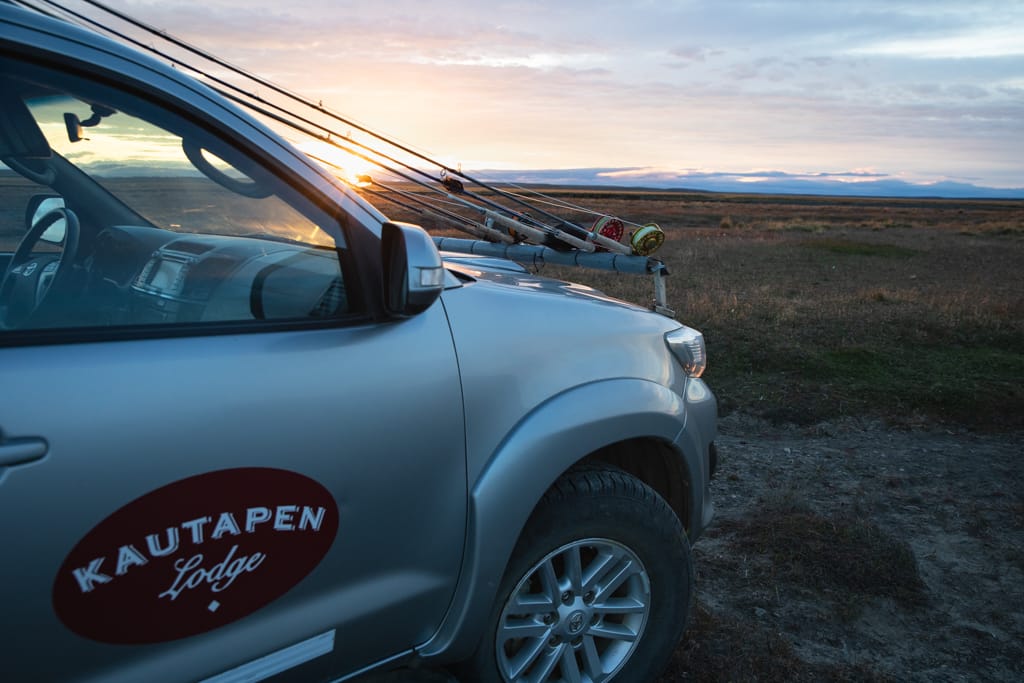
Rain the day before had given the river a much needed lift, and on my first day at Kau Tapen, the water was still coloured but more than fishable. It was early in the season, and the water had been lower than average, so the fish had yet to flood into all parts of the river in great numbers. The rise could only be a good thing and help to encourage the run to travel upstream. Visibility was only a few feet, so Max, our guide, suggested a large rubber legs or a small leech. The girdle bug I chose looked related to a sea urchin with white spines. I started in the fast streamy water at the head of Dead Guanaco, unrolling the line, then plucking it back with short strips to get the legs working. In less than a foot of water, a fish slammed the fly. Before Max could slip the net under, the hook pulled. This time it had straightened. It is always a risk using long-shanked hooks on a river like this. Hooking a bright fish in this kind of shallow and streamy water suggested it was a running fish. This was confirmed further down when I saw a double-figure sea trout on the inside of the current in water so shallow its back was almost dry.
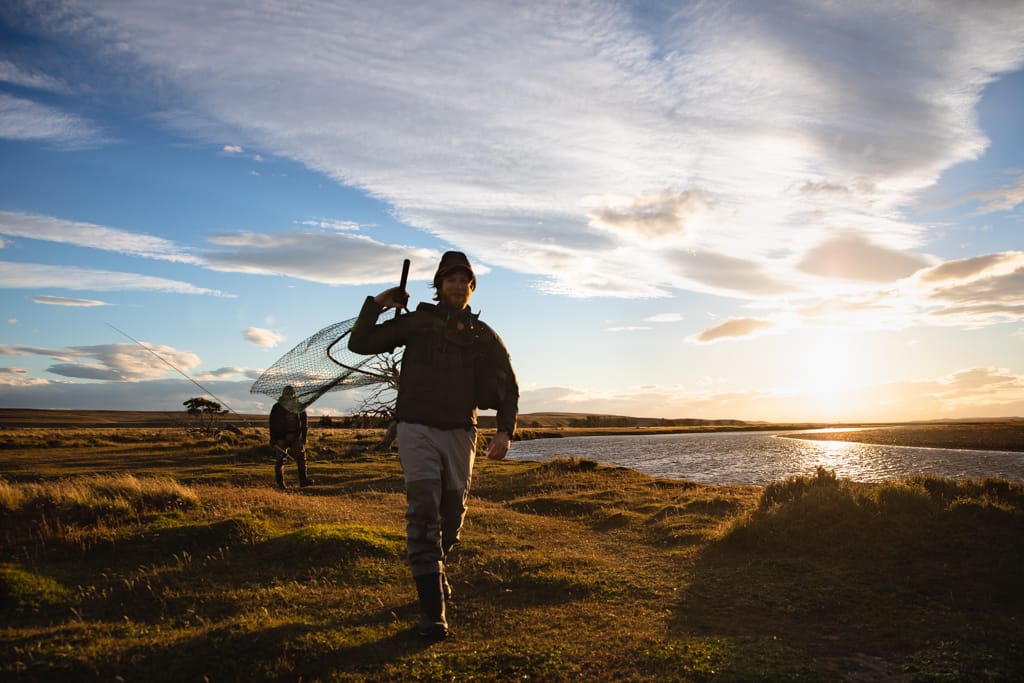
On our return to the lodge, we were welcomed by Sofia and Manuel, a cold mint and strawberry smoothy and a warm, clean cloth to refresh and wipe our face with. The lodge seems to do so well with small touches like this. Sebastian, the chef, prepared another feast for lunch that was more than was necessary, but as I am greedy, I found it hard not to say yes when asked if I would like more. As many will know, the Argentine diet is a meat heavy one. I think I am right in saying that they consume more beef per capita than almost any other country. Given how well they do beef, this is hardly surprising. For those that are not die-hard carnivores, Kau Tapen does offer a lighter option, which I chose several times for the evening meal.
The afternoon was as bright as the morning, making for testing conditions. It is very rare on the Rio Grande to several days of sun in a row, and although nice, it makes for challenging fishing, as was the case until the light dropped. The day had been tough, tougher than I had hoped, but dying light rewarded our efforts with one of the most spectacular sunsets that I have seen on the river. A little like in Africa, the sunsets in Argentina are unlike any we see at home. Especially on the Rio Grande, where the skies are so big and the landscape so open. I stopped fishing and instead watched the sky flame to burnt orange and shades of yellow and red. I was in the land of fire, and to continue fishing blindly would have chanced ruining the moment.
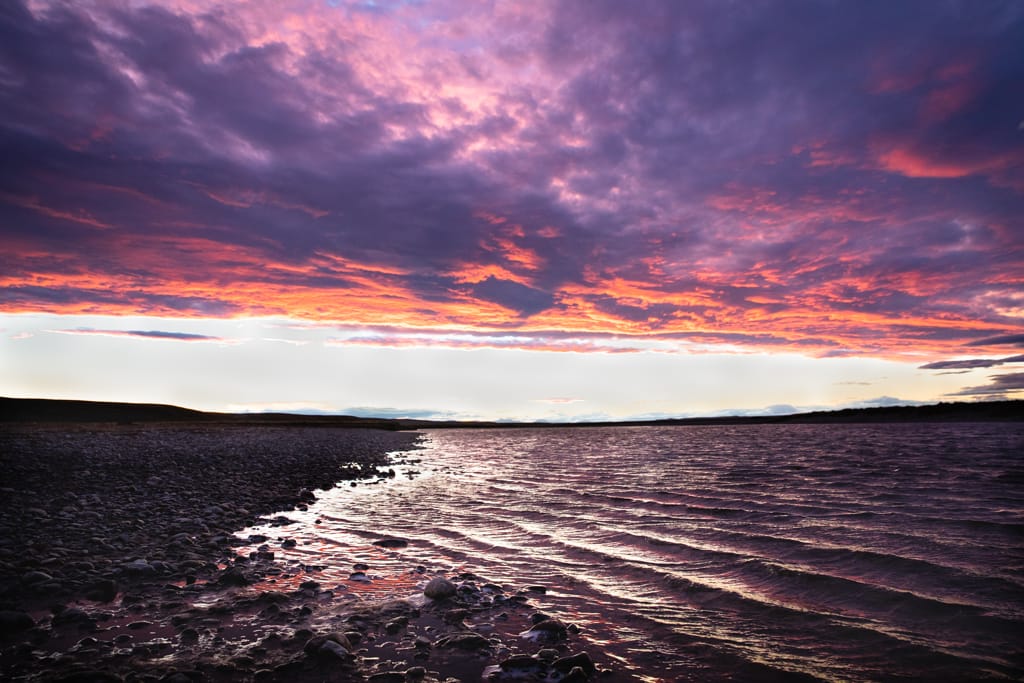
One of the most exciting developments at Kau Tapen since I was last there was made clear to me the following day when we fished with the head guide, Gaston. We were only able to drive to the lowest part of the Menendez River during my time. Some of the best pools like Bill’s Black and Amphitheatre could only be accessed on foot which took too much time from the session and was not a realistic prospect for many clients. This has now changed as there are tracks to all the best pools on the Menendez.
The Menendez was carrying more colour than the main river, which had cleared after the recent rain. A little colour was by no means a bad thing, especially when fishing a small and technical river. The river spans no more than ten meters from bank to bank. Despite being petite, the fish are no smaller than in the main river, and some would argue that the average size is larger. One sure thing is that the Menendez is not a place for large two-handed rods, as accuracy is essential, and the casts never need to be long. A 10ft 8 weight proved ideal.
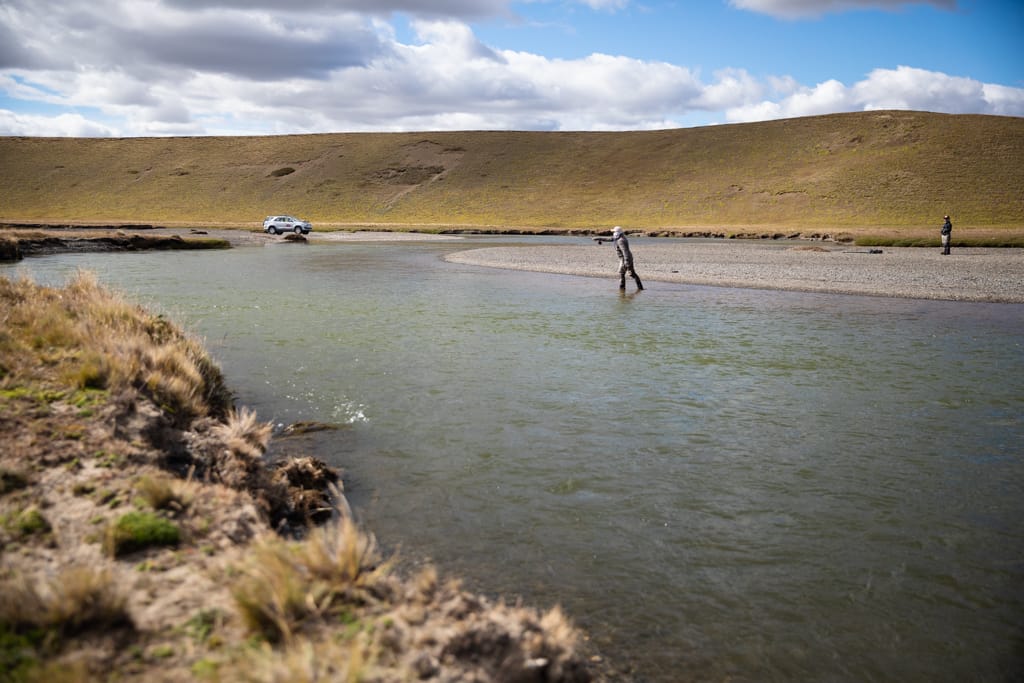
Gaston focused on Igor while I made sure to cast close to the far bank and mend enough to hold the black leech in the deeper pockets for as long as possible. This was active fishing, not chucking and chancing. Two firm pulls rewarded my efforts, but no more. When fishing the Rio Grande, a nagging question when a fish takes is always ‘was that one of the big ones?’
By lunch, the sun was beaming brighter than ever, the wind had dropped to not even a puff, and it was over twenty degrees, a trend that would continue for the next two days. Almost unheard of in this part of the world, and a nice dose of winter sun but not conducive to sea trout taking well. When the fishing is challenging, it is easy to get despondent and think of little but your woes. But on this river, more than most, you must remind yourself that it only takes one firm pull and one fish to turn a tough week into one that remains forever memorable. It is not a place where anglers bend the rod every five minutes. Although the action can come thick and fast, it is a place you go to capture memories and a fish of a lifetime.
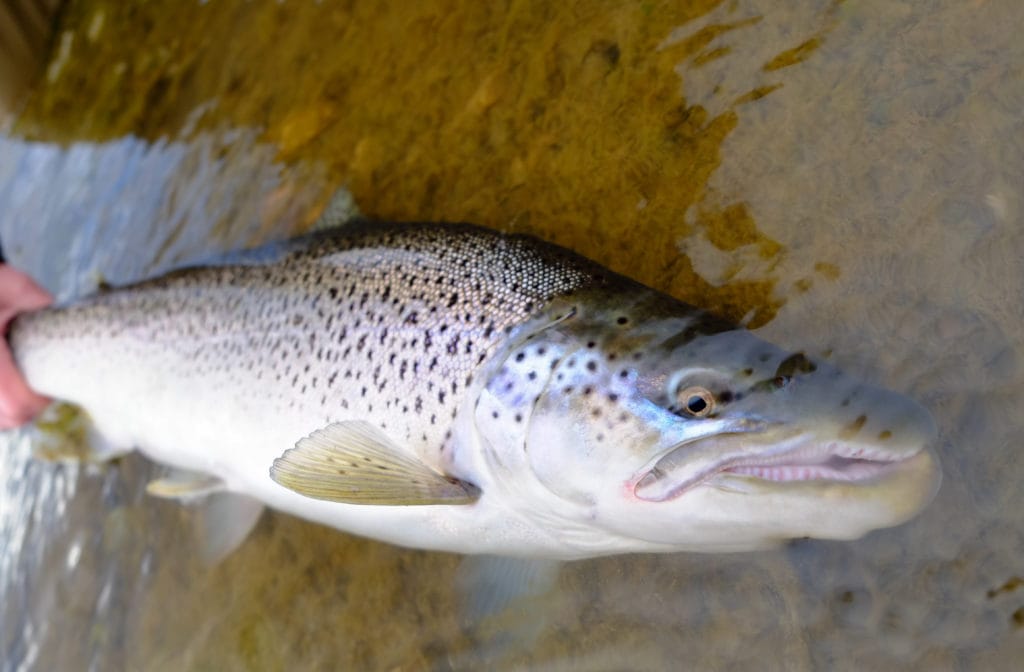
It was great to see Santi again, as we had guided the river together. He was exactly as I remembered, fun and talkative. Long leaders seemed essential to match the lack of wind and cloudless skies. I suspended a chartreuse green machine behind a green nymph tied in the style of an EMB and began working through Nirvana, the pool I had caught my first fish in with Ropo. Now I have been on the river for a few days, I had begun to recognise and remember the small subtleties that made the best taking spots. The tallest part of the high bank twenty meters downstream and where the river pinched together looked like one. A bright fish in the mid-teens confirmed that this was the case. Its flank gleamed silver as it turned in the morning sun. I tried not to rush towards the fish too quickly and instead continued with my methodical dissection of the water. Soon, my team of green was inching closer to the fishes lie. Using the features of the high bank, I had noted where the fish had jumped and knew that I would cover it within the subsequent few casts. Pluck, pluck, pluck. Pluck. Whack. A firm take, but then nothing. Cast again, another take, but this time something more. I bent into the fish but knew straight away that it was not the one that jumped but smaller. It was a fresh, healthy cock fish close to ten pounds and my second from Nirvana that trip.
For the first time in days, the sky clouded over that afternoon. The wind remained light and could not have been more than ten miles an hour at its strongest. We had Condor in the afternoon, one of the closest beats to the lodge and less than ten minutes drive away. The beat has a good mix of pools, with the standouts being Condor, Fernando’s and Jackie’s. While Santi and Igor went to Fernando’s, I spent the magic hour at Jackie’s, the smallest of the three but no less fishy. The head of the pool is a mix of fast current and boulders, which is usual for the river. The river then sweeps left in a gentle curve before straightening out. ‘From where the current meets the high bank, and the next thirty meters is the best water.’ Santi tells me, pointing with a straight arm from the car’s window. Rather than fish with a leech, I choose a six-inch sunray instead. The aluminium tube is slightly bent but not enough to warrant it unusable. I recognise it as one of the sunrays I tied in the Kau Tapen guide house. The same fly has had several salmon to its name since. Thanks to lashings of superglue, it is yet to fall apart. A squarer cast and long smooth strips induce a gentle take and a landed fish. Another torpedo-shaped sea trout fresh from the salt.
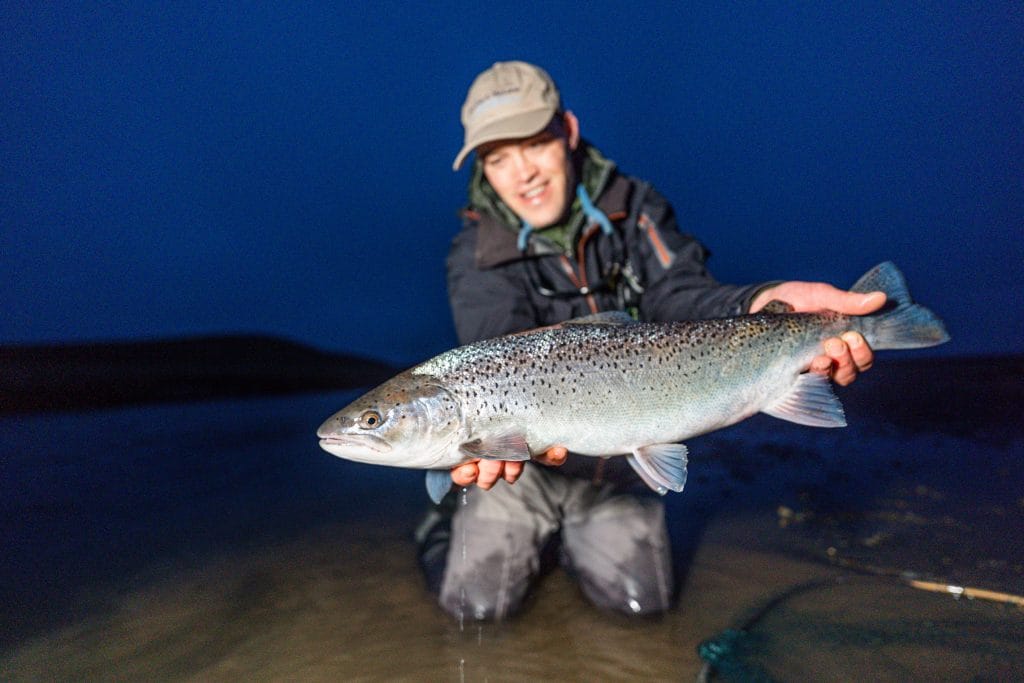
I was delighted to have one last opportunity to fish the Menendez. Although I love the main river, there is something special about this excellent tributary. The water had cleared a lot since our previous visit with Gaston, so we went straight to a rubber legs rather than fish a leech. Despite each cast filled with nervous anticipation for what would happen next, I felt no more than two firm pulls. Igor had a similar story to tell. We had to wait until the evening again for the river to come alive. Rather than choose the main river for the dying light, Colo made the bold move of returning to the Menendez. We fished Oliver Poacher a small pool which I had never fished. It was more of a pocket than a proper pool as the taking area was less than ten meters long. It looked best where the main current slowed next to a three-meter clump, which I could just see the outline of in the failing light. At a stretch, the far bank was within poking distance with the tip of my rod, so to avoid hooking the clump, I inched the line out little by little. I had now seen the shadows and heard the splash from two fish moving, so I expected the line to tighten soon. The line did more than tighten a few casts later and ripped from my fingers. To stop the fish from wrapping around the clump, I sprinted downstream and stripped to get a better angle. The fish not only jumped but pulled hard and thrashed its head like a Jack Russell, desperate to escape its leash. It was an intense but short fight, and I soon admired the fish in the shallows. Admiring the fish, not for its size, but lack of. It was a nice sea trout and by no means was I complaining, but I was a little bemused about how a fish fewer than ten pounds could pull so hard.
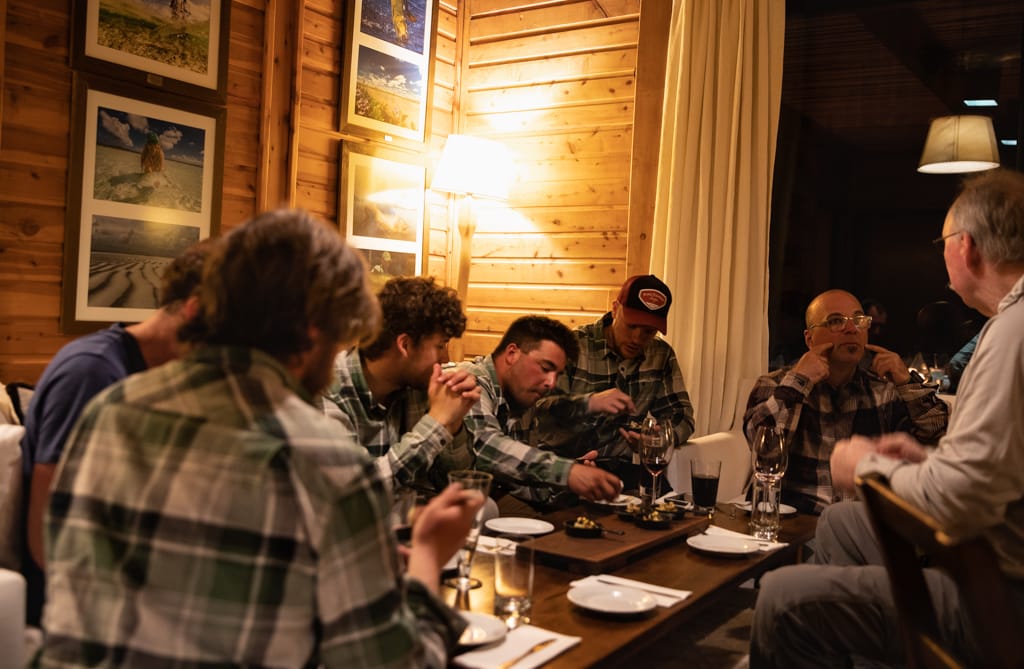
We spoke of the evening before on the journey to Ushuaia the following day. Everyone had caught fish. Some had caught more, and some larger than others. The river had shown us enough of the kind of fishing it can produce, a whisper, a whisper that said ‘come back.’
Although long, the journey to Ushuaia was far less painful than I had imagined. This was mainly helped by the stunning landscape we drove through and a stop at a delightful bakery in Tolhuin. My trip to Tierra Del Fuego seemed to have come and gone in what seemed a blur, and the prospect of returning to short days and bitter nights was not a welcome one. Watching the rain lash against my office window confirms that going away after Christmas is not only welcome but necessary, and I am already looking forward to Argentina next year.
